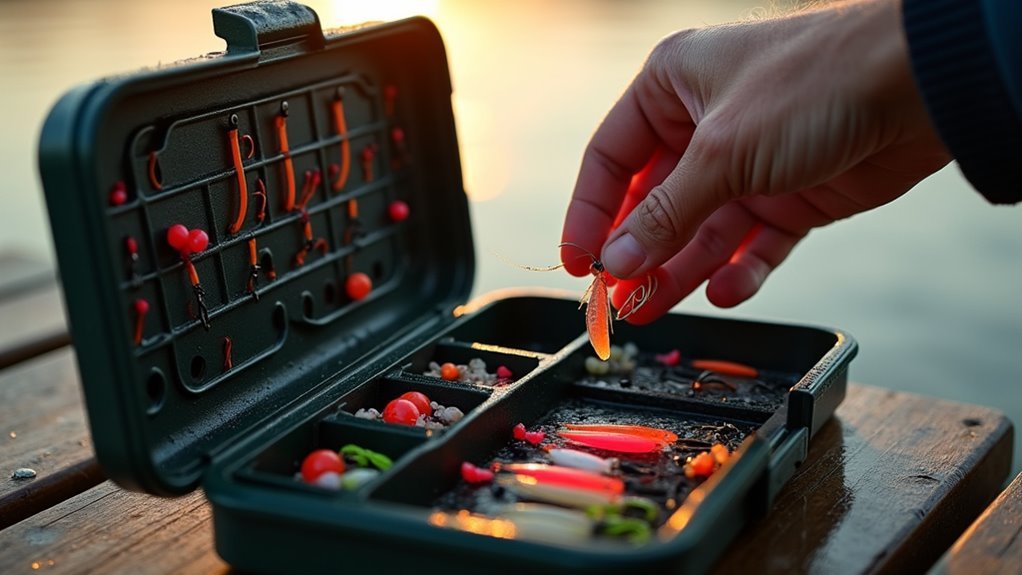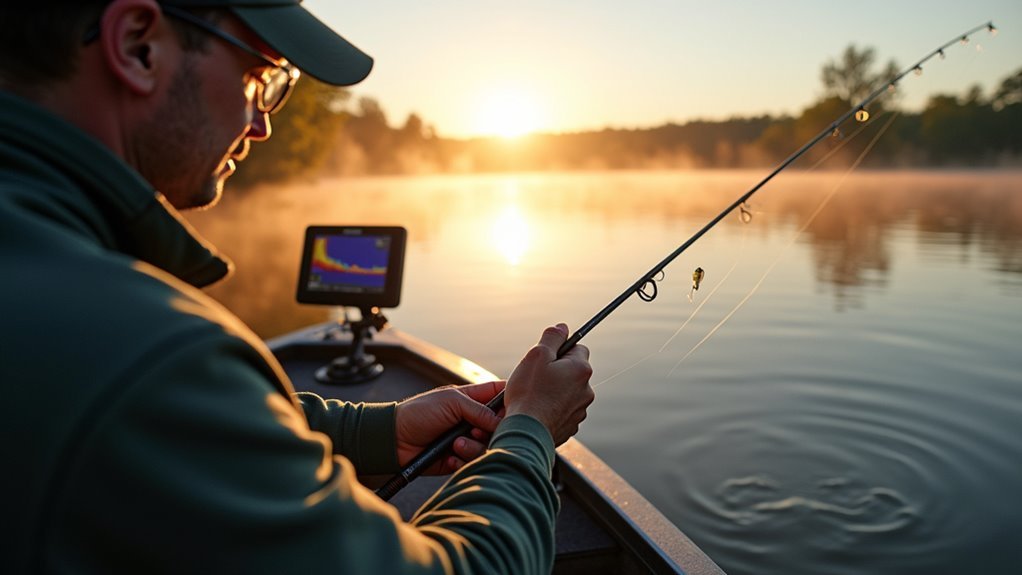When fish aren’t biting, we’ll need to switch to finesse techniques. We’ve found that downsizing to lighter gear—6-7 foot spinning rods with 8-10lb braid and fluorocarbon leaders—makes all the difference. Watch for signs like fish following without striking or increased water clarity. Our go-to rigs include the Ned, Drop Shot, Wacky, Neko, and Shaky Head. We’ve landed 5-pounders on tiny presentations when nothing else worked. Slow down your retrieve, then slow it even more to reveal finesse fishing’s full potential.
When to Switch From Power to Finesse Fishing

While we’d all love to catch monster bass on big swimbaits every day, sometimes the fish just aren’t playing along. That’s when it’s time to downsize our approach.
We’ve all been there – casting aggressively for hours without a bite. Pay attention to these signals: when fish follow but don’t strike, when water clarity drops, or during cold fronts. After fishing pressure (like weekend tournaments), bass get wise to aggressive tactics.
I remember a scorching July day when nothing worked until I tied on a tiny Ned rig. Eight bass later, I was a believer! Additionally, understanding battery capacity can help ensure you have enough power for longer fishing sessions while finesse fishing.
Essential Gear for the Finesse Approach

Successful finesse fishing starts with the right equipment in your tackle box. We’ve found that lighter spinning rods in the 6-7 foot range paired with 2500-3000 series reels create the perfect balance for those subtle presentations.
For line, we typically spool up with 8-10lb braid and add a 6-8lb fluorocarbon leader to stay invisible to wary bass. I remember catching a 5-pounder on a crystal-clear lake when everyone else went home empty-handed—all thanks to downsizing my presentation.
Don’t forget smaller hooks (size 1-2) and lighter weights (1/16-1/8oz) to maintain that natural action.
Top Finesse Rigs and Their Applications

Once you’ve got your gear sorted, mastering the right finesse rigs can make all the difference between a frustrating day and a livewell full of bass. We’ve caught countless finicky fish using these proven setups when nothing else would work.
Mastering finesse techniques transforms tough days into personal bests when conventional tactics fail.
- Ned Rig – perfect for pressured lakes and clear water conditions
- Drop Shot – excels when bass are suspended or holding tight to structure
- Wacky Rig – deadly when fish are inspecting but not committing to baits
- Neko Rig – combines wacky action with better snag resistance
- Shaky Head – our go-to when fishing around rocky bottoms
Advanced Techniques for Pressured Waters

As heavily fished lakes and rivers become increasingly challenging, we’ve developed specialized finesse approaches that consistently produce when other anglers go home empty-handed. We’ve found that downsizing our presentations and slowing our retrieves makes all the difference when bass have seen everything twice.
| Technique | Best Conditions | Key Tackle |
|---|---|---|
| Dead-sticking | Cold fronts | 3″ straight worms |
| Micro-jigging | Clear water | 1/16 oz marabou jig |
| Skip-casting | Docks/overhangs | 2.5″ tubes |
| Drop-shotting | Deep structure | #1 finesse hooks |
| Small swimbaits | Suspended fish | 2″ paddle tails |
Remember when fishing pressured waters: if you think you’re fishing slow enough, slow down even more!
Frequently Asked Questions
How Does Water Clarity Affect Finesse Fishing Strategy?
We’ll need to adjust our finesse fishing approach based on water clarity. In clear water, we’ll use lighter lines and natural colors. In murky conditions, we’ll opt for more visible baits and stronger presentations.
Can Finesse Fishing Be Effective in Heavy Vegetation?
Yes, we can use finesse fishing in heavy vegetation. We’ll need weedless rigs like Texas rigs or finesse jigs with light line. They allow for precise presentations in tight spots where bass hide.
What’s the Ideal Hook Size for Finesse Presentations?
For finesse presentations, we typically recommend hook sizes between #1 and #6. We’ll go smaller (4-6) for Ned rigs or drop shots, and larger (1-2) for finesse worms and shaky heads.
How Do Seasonal Patterns Impact Finesse Fishing Success?
We’ll need to adapt our finesse fishing across seasons. In cold months, we’re fishing deeper and slower. During spawn, we’re targeting beds. Summer requires early morning efforts, while fall calls for following baitfish movements.
Are There Finesse Techniques Specifically for Night Fishing?
Yes, we’re using lighter tackle at night too! We’ll opt for dark-colored finesse jigs, add rattles to shaky heads, or use scented soft plastics that bass can locate without relying on sight.
Conclusion
We’ve walked you through the finesse fishing playbook, from when to use it to advanced techniques for those stubborn lunkers. Remember, finesse fishing isn’t just a technique—it’s your ace in the hole when conventional methods fall short. Next time the bite turns tough, scale down your presentation and slow things down. With practice and patience, you’ll be reeling in fish when others are high and dry. The proof is in the pudding—and your livewell!